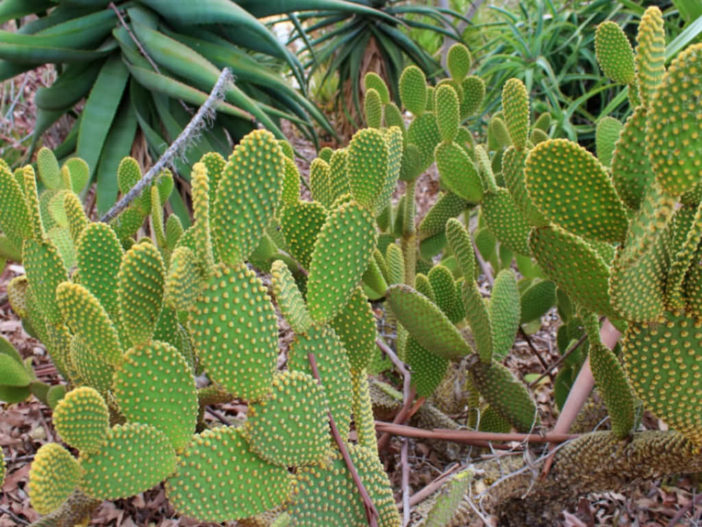Scientific Name
Opuntia microdasys (Lehm.) Pfeiff.
Common Name(s)
Bunny Ears, Bunny Ears Cactus, Bunny Cactus, Polka Dot Cactus, Bunny-ears Prickly-pear, Angel's Wings, Golden-Bristle, Golden-Bristle Cactus
Synonym(s)
Opuntia microdasys var. microdasys, Cactus microdasys, Opuntia macrocalyx
Scientific Classification
Family: Cactaceae
Subfamily: Opuntioideae
Tribe: Opuntieae
Genus: Opuntia
Description
Opuntia microdasys is a popular cactus that forms a dense shrub with green pad-like stems with no spines but numerous yellow glochids at each areole. It grows up to 3 feet (90 cm) tall and up to 6 feet (1.8 m) wide. Stems are oval to round, up to 6 inches (15 cm) long, and up to 5 inches (12.5 cm) wide.
Flowers are pure yellow or tinged with red, up to 2 inches (5 cm) long, up to 1.6 inches (4 cm) in diameter, and appear in summer. They are followed by round to egg-shaped, up to 2 inches (5 cm) long, red to purplish fruits.

Hardiness
USDA hardiness zones 9a to 11b: from 20 °F (−6.7 °C) to 50 °F (+10 °C).
How to Grow and Care
A spot near a south-facing unobstructed window is most likely to meet Bunny Ears Cactus' need for bright, direct sun. Windows with western or eastern exposure run as the second and third choices. While an actively growing Bunny Ears Cactus tolerates indoor summer temperatures as high as 100 °F (38 °C), don't expect it to flower unless you also provide winter temperatures between 45 and 55 °F (7 and 13 °C). Regardless of the season, it likes humidity in the 10 to 30 percent range. Finally, if none of your windows provides adequate light, place the plant 6 to 12 inches (15 to 30 cm) below a cool white fluorescent tube for 14 to 16 hours each day.
The potting soil must drain quickly. Use a commercial cactus potting mix or mix your own. The best container for your cactus is a clay pot, slightly larger and deeper than the plant's root system. It must have drainage holes because a pot without them or a pot that's too large could make proper watering impossible.
Learn more at How to Grow and Care for Opuntia.
Origin
Opuntia microdasys is native to central and northern Mexico.
Varieties and Forms
- Opuntia microdasys var. albispina
- Opuntia microdasys var. pallida
- Opuntia microdasys var. pallida f. cristata
Links
- Back to genus Opuntia
- Succupedia: Browse succulents by Scientific Name, Common Name, Genus, Family, USDA Hardiness Zone, Origin, or cacti by Genus
Photo Gallery
Click on a photo to see a larger version.



